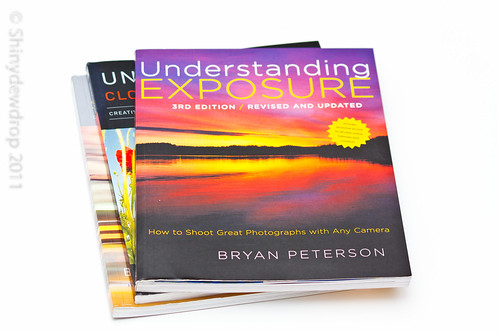
All three books are by Peterson, and although I normally won't buy multiple books from the same author before trying one out, I'm actually glad I did and it wasn't a mistake.
Bryan Peterson's style of writing is very lucid, and although not as entertaining as Scott Kelby's, he does a pretty good job of explaining his point.
Whatever I have ever learned of photography, was by reading, or by doing. I used to read a lot of books, and online publications, and I have then practised what I learned from them. When I ordered these books, I was a little bit skeptical about whether they would be worth my money or time. I haven't had a lot of time to devote to reading lately, but I love collecting books anyway. Therefore, I thought it might be a nice idea to add a few more volumes to my night table (since I don't really have a bookshelf/library). But, the book reads really well and these are some of the topics Peterson discusses in this edition:
- What is exposure? Is it only light, or does it also refer to the image that is a result of exposing the film or sensor to light?
- The best type of light for photography
- How exposure is relative to shutter speed and ISO
- Low light photography
- How depth of field affects exposure
- Metering and white balance
- Filters and techniques used to achieve a good exposure
These are just a few topics that he discusses in this 176-page book.
He covers a lot of ground and some units even have little exercises at the end that you could follow to reinforce what he explains in the preceding pages. I thought it was a great idea! If you're the kind that likes to read and then put your learning into practise, you will love these little mini exercises. And what better way to really apply the theory, than by testing it?
And of course, there are lots and lots of pictures. Some before-and-after type of shots to elucidate his points are really helpful in seeing what he's talking about.
But the best part of the book is the examples he chooses to explain his theories! I loved those! He picks on real-life examples and that makes it so easy to understand the concepts. For example, he likens the area of focus of an aperture in a camera to that of an empty bucket into which a one-gallon can of paint is poured.
As you pour the paint into the empty bucket, some of the paint splatters up the sides of the bucket causing a spill. However, if the paint is poured through a funnel with a tiny opening, the paint doesn't spill and there is no splatter. Similarly, when the aperture is wide open with a small area of focus, the light comes in and renders the small area of focus really sharp, whereas the rest of the light entering the camera is like the splatter that results in the blurred, out-of-focus areas. And when the aperture is really narrow (like the narrow opening of a funnel), the light enters the camera in a cleaner and more controlled fashion and creates a larger depth of field, i.e. a sharper image with a larger area of focus.
Peterson scatters these types of examples throughout the book, and that makes for a great read and really aids comprehension of topics that otherwise take newbies ages to grasp. And I was no exception either. But, even for people like myself, who have been doing photography for a while and understands the basics, it's really nice to get a refresher and discover some really neat tips and tricks that he includes in every unit.
All in all, a great book for beginners, as well and intermediate photographers. Please look out for two more book reviews in the near future.
Just an additional note - I recently signed up to be an Amazon Associate, so if you decide to purchase this book, I'd really appreciate if you used the embedded link at the beginning of this post to do so. And do drop me a line to let me know you did, or if you have any questions.
I have Kelby's book. I loved reading his because of the way he writes it. It's fun and makes me keep going on reading. Just like you, I learned some photography knowledge through following blogs, looking at other people's finish product for inspiration and some reading.
ReplyDeletePeterson's is in my next list after I am done with Kelby's Vol 1, 2 and 3. I got lucky to get a boxed set. :)...